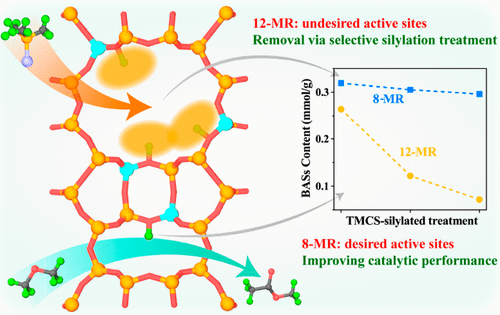当前位置:
X-MOL 学术
›
ACS Catal.
›
论文详情
Our official English website, www.x-mol.net, welcomes your
feedback! (Note: you will need to create a separate account there.)
Selective Removal of Acid Sites in Mordenite Zeolite by Trimethylchlorosilane Silylation to Improve Dimethyl Ether Carbonylation Stability
ACS Catalysis ( IF 11.3 ) Pub Date : 2022-04-01 , DOI: 10.1021/acscatal.1c05896
Rongsheng Liu 1, 2 , Shu Zeng 1, 2 , Tantan Sun 1 , Shutao Xu 1 , Zhengxi Yu 1 , Yingxu Wei 1 , Zhongmin Liu 1, 2
ACS Catalysis ( IF 11.3 ) Pub Date : 2022-04-01 , DOI: 10.1021/acscatal.1c05896
Rongsheng Liu 1, 2 , Shu Zeng 1, 2 , Tantan Sun 1 , Shutao Xu 1 , Zhengxi Yu 1 , Yingxu Wei 1 , Zhongmin Liu 1, 2
Affiliation

|
Catalysis research always pursues more efficient catalysts and realizes selectivity-controlled conversion. The local environment of acid sites in a zeolite is regarded as the vital reason for its catalytic selectivity in many chemical reactions. Herein, we have demonstrated that the acid sites in the 12-membered-ring (12-MR) channels of mordenite zeolite could be selectively covered by a trimethylchlorosilane (TMCS) silylation treatment, which could significantly improve the dimethyl ether (DME) carbonylation performance. Detailed mechanism studies by in situ DRIFT, 1H MAS NMR, and FTIR spectra analyses indicate that the TMCS species replace the Brønsted H+ in the bridging hydroxyl groups when chloro groups are rapidly hydrolyzed by the protons, accompanied by the formation of siloxane bonds. Due to the space limitation, the silylation reaction mainly occurred in the 12-MR channels and created most of the remaining acid sites (80%) in the 8-MR channels of the MOR zeolite, which gave better selectivity and a much longer lifetime in the DME carbonylation reaction. This work realizes a conceptual pathway to selectively control the distribution of acid sites within different confinement positions of zeolites to improve the catalytic selectivity of catalysts.
中文翻译:

三甲基氯硅烷硅烷化选择性去除丝光沸石中的酸性位点提高二甲醚羰基化稳定性
催化研究始终追求更高效的催化剂,实现选择性可控转化。沸石中酸性位点的局部环境被认为是其在许多化学反应中催化选择性的重要原因。在此,我们证明了丝光沸石的 12 元环 (12-MR) 通道中的酸性位点可以被三甲基氯硅烷 (TMCS) 硅烷化处理选择性覆盖,这可以显着提高二甲醚 (DME) 羰基化性能. 通过原位DRIFT、1 H MAS NMR 和 FTIR 光谱分析进行的详细机理研究表明,TMCS 物种取代了 Brønsted H +当氯基被质子快速水解时,桥接羟基中的羟基,伴随着硅氧烷键的形成。由于空间限制,甲硅烷基化反应主要发生在 12-MR 通道中,并在 MOR 沸石的 8-MR 通道中产生了大部分剩余的酸性位点(80%),从而提供了更好的选择性和更长的寿命。 DME羰基化反应。这项工作实现了一种概念性途径,可以选择性地控制沸石不同限制位置内的酸位分布,以提高催化剂的催化选择性。
更新日期:2022-04-01
中文翻译:

三甲基氯硅烷硅烷化选择性去除丝光沸石中的酸性位点提高二甲醚羰基化稳定性
催化研究始终追求更高效的催化剂,实现选择性可控转化。沸石中酸性位点的局部环境被认为是其在许多化学反应中催化选择性的重要原因。在此,我们证明了丝光沸石的 12 元环 (12-MR) 通道中的酸性位点可以被三甲基氯硅烷 (TMCS) 硅烷化处理选择性覆盖,这可以显着提高二甲醚 (DME) 羰基化性能. 通过原位DRIFT、1 H MAS NMR 和 FTIR 光谱分析进行的详细机理研究表明,TMCS 物种取代了 Brønsted H +当氯基被质子快速水解时,桥接羟基中的羟基,伴随着硅氧烷键的形成。由于空间限制,甲硅烷基化反应主要发生在 12-MR 通道中,并在 MOR 沸石的 8-MR 通道中产生了大部分剩余的酸性位点(80%),从而提供了更好的选择性和更长的寿命。 DME羰基化反应。这项工作实现了一种概念性途径,可以选择性地控制沸石不同限制位置内的酸位分布,以提高催化剂的催化选择性。

































 京公网安备 11010802027423号
京公网安备 11010802027423号